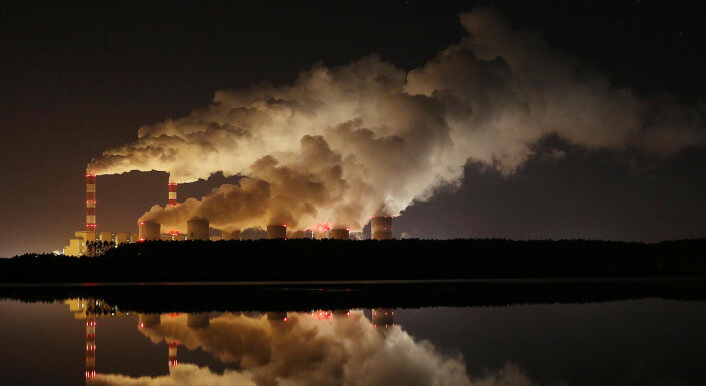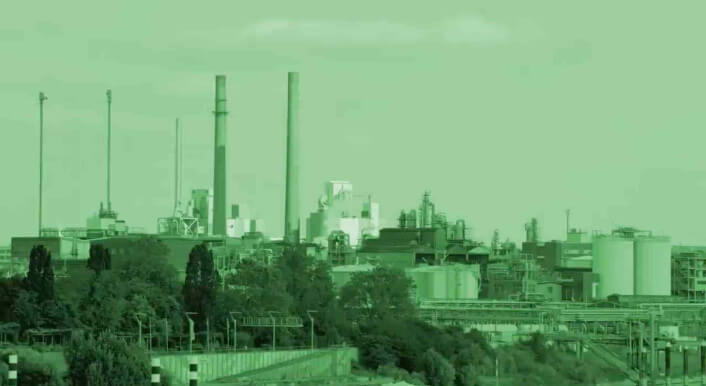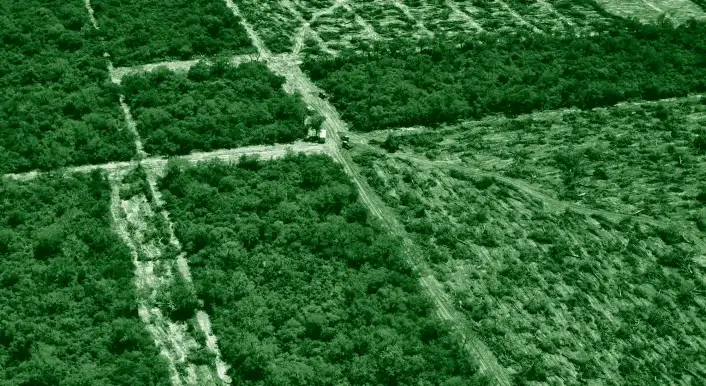Industrial air pollution costs Europe 265 billion euros in one year
Europe's coal-fired power plants poison our air like no other industry. Giants such as PGE, RWE or Vattenfall emit tons of pollutants yearly, with harsh consequences for our health and the environment. The damage cost us billions of euros.

When you type “Bełchatów” into an internet search engine, the first photos that appear show a large open-pit mine with a huge industrial facility in the background. It is no coincidence at all that the plant has turned into the most recognizable icon for the Polish town.
Located 160 kilometers southwest of Warsaw, Bełchatów is home to Europe’s largest coal-fired power station. A monster that gobbles up lignite so voraciously that by 2036, the local reserves of the mineral will have been consumed. Satellite images of the area clearly show the wound left by the mine — or rather, the mines — that feed the power station: a series of brownish patches on an otherwise green surface.
Such is the pollution generated by this giant that, according to calculations by the European Environment Agency (EEA) available to CORRECTIV.Europe, Bełchatów cost Polish society €4.8bn in terms of damage to the health of its inhabitants, premature deaths and poorer harvests, among other things — and this in 2017 alone. The power plant leads the ranking of the most damaging industrial facilities issued by the EEA, which includes over 11,600 industrial sites in Europe.
In 2021 alone, according to EEA emissions data, Bełchatów released over 33 million tons of CO2, more than twice Slovenia’s carbon dioxide emissions for that same year.
However, the future of the plant is already sealed. In 2020, the District Court of Łódz, the region where the mammoth electricity producer is located, ruled in favor of the environmental organization ClientEarth, which demanded the closure of Bełchatów. The ruling forced the owners of the power plant, the public company Polska Grupa Energetyczna (PGE), to negotiate with the British organization the decommissioning of the largest carbon dioxide emitter in Europe. ClientEarth’s lawyers had requested that PGE shut down all units by 2035. According to information made public by PGE, that will happen by 2036, although some units will already be off the grid before that. In its Territorial Just Transition Plan, passed last April, the region of Łódz confirms this: “By 2028, mining at the Bełchatów Field will be completed, and one of the 380 MW units will already be reported for shutdown by 2030”.
Alleging that the case is still in the court of first instance, ClientEarth refused to give further details about the latest developments in the lawsuit. PGE did not react to repeated efforts by CORRECTIV.Europe to contact the company.
The price of coal
The Polish coal power plant has become a poster child of the fight against climate change, but Bełchatów is unfortunately not alone: in total, 24 of the top-30 dirtiest facilities in Europe are thermal power stations, most of which use coal. They also have a high price tag: over €45 billion, paid for by citizens in nearby areas with their health. For years, they have been inhaling fine dust or sulfur oxide coming from these plants. Fine dust, also known as particulate matter, is especially damaging.
“Particulate matter can penetrate deep into the lungs and, like nitrogen dioxide pollution, lead to respiratory and cardiovascular disease”, says Dorothea Baltruks, research associate at the Centre for Planetary Health Policy (CPHP) in Berlin. These emissions are particularly harmful to people living close to major roads or industrial facilities such as coal-fired power plants, Baltruks told CORRECTIV: “It’s especially dangerous for children, pregnant women and people with pre-existing conditions”.
Methodology
The European Pollutant Release and Transfer Register (E-PRTR) provides public access to key environmental data from industrial facilities in EU Member States, Iceland, Liechtenstein, Norway, Switzerland, Serbia and the UK.
The E-PRTR is updated annually with data reported by some 35,000 industrial facilities covering 65 economic activities. This data includes 91 key pollutants such as heavy metals, pesticides, greenhouse gases and dioxins. Only 60 of them are likely to be released into the air.
After analyzing the topic with experts and different scientific sources, as well as reviewing the EU legislation, we have decided to use the following pollutants for our investigation:
Main air pollutants: PM10, Ammonia (NH3), Nitrogen oxides (NOx), Sulphur oxides (SOx) and Non methane volatile organic compounds (NMVOC).
Greenhouse gases (GHG): Carbon dioxide (CO2), Methane (CH4), Nitrous oxide (N2O)
Air pollutants have certain threshold values. Above this threshold, a facility must report its emissions to the European Union. If a plant is below this threshold, it does not have to report the emissions and they do not appear in the data.
But not only this: Other energy giants like Germany’s RWE or Sweden’s Vattenfall have also significantly contributed to global warming with heavy CO2 releases to the atmosphere, which do not only affect the local population.
Contamination does not stop at the border
“Air pollution is indiscriminate and ignores regional and national borders. Emissions lead to damage, and the costs are borne by society as a whole”, writes the EEA.
These costs are pretty high: €265 billion in 2017 alone, more than Finland’s GDP for that year. They are caused by just a bunch of large industrial contaminators in Europe: 211 facilities, barely 2% of over 11,600 analyzed by the EEA, are responsible for half of the damage produced by dirty air. Poland, Germany or Italy are among the top polluters: Poland has the second-highest overall cost (€27 billion) after Germany (€60 billion). Italy makes it into the top 5, with more than €19.8 billion, only after the United Kingdom (€25 billion) and Spain (€20.7 billion). These five countries accounted for almost 60% of all costs borne by European society in 2017.
Even smaller countries, such as Hungary, pay high costs for air pollution from their industry: €3.8 billion in 2017. Coal-fired power plants also play a key role here, with the power station in Visonta being responsible for a fourth of the costs for Hungarian society.
Europe's ammonia problem
In general, the EU has managed to keep its industrial emissions under control in recent years and even reduce them for most substances, with one exception: ammonia. After a slight decrease between 1990 and 1995, its emissions have stagnated.
Although the applicable EU legislation is mainly meant for industrial activities, it also affects large poultry and pig farms. For a good reason: the main source of ammonia, one of the main air pollutants, is agriculture — 94% of all releases in the EU come from this activity. This gas is discharged to the atmosphere mainly from manure management and the application of fertilizer to soils, and the number of livestock is one of the factors driving the emission trends.
In 2021, France, one of the main European agricultural producers, was also the largest ammonia emitter, followed by Germany, Spain and Italy. These four countries account for two-thirds of all European ammonia releases. The EU-27 has committed to cutting its ammonia emissions by 19% in 2030. In 2021, that reduction was only 2.4% compared to a year earlier.
The EEA admits that reducing ammonia releases remains the biggest challenge for the next few years, since only five countries are already aligned with their pledge to cut these emissions by 2030. The environmental office also recommends that Member States “include more measures applicable to the agricultural sector in their national air pollution control programmes”.
Europe clearly has an ammonia problem. However, the picture is not complete: although there were almost 75 million cows in Europe in 2022, cattle farms do not have to report their emissions, only poultry and pig rearing do.
Key pollutants and activities excluded
This example shows that, although the EU emissions register is a good tool, it has limitations. It dates back 17 years and is obsolete. For this reason, the European Commission and the European Parliament have been in the process of revising the law to cover additional intensive farming and industrial activities since 2022.
However, the way is not easy. While the Commission had proposed to include cattle in the new legislation, the EU Parliament has voted against this possibility.
“It makes no sense that they are excluded. That’s a privilege”, says Luis Ferreirim from Greenpeace Spain, pointing to the industry's lobbying efforts. He hopes that the next steps of the political negotiations can lead to a consensus position, “even if it is not as ambitious as the original proposal by the European Commission”. The lack of data, says Ferreirim, makes it impossible for organizations like Greenpeace and experts on the topic to know how much pollution intensive cattle farms release into the air.
Information on air pollutants
Here is a summary of the effects that each of the pollutants can have on human health or the environment (from the Industrial Emissions Portal):
PM10
In terms of potential to harm human health, particulate matter is one of the most important pollutants as it penetrates into sensitive regions of the respiratory system, exacerbating respiratory illnesses such as asthma and contributing to increased prevalence and incidence of other cardiovascular diseases and premature death. Smaller sizes of particulate matter (e.g. PM ) are considered particularly harmful due to their greater ability to penetrate deeply into lungs.
Ammonia
At high local concentrations (e.g. from decomposing manure) ammonia can cause harm to vegetation, but greater damage is from releases of aqueous ammonia to water bodies as it is very toxic to aquatic organisms. Emissions of ammonia to air can also contribute to the formation of particulate matter, an important pollutant in terms of its potential to harm human health.
Nitrogen oxides
Of the chemical species that comprise the NOx air pollutant, it is NO2 that is associated with adverse effects on health, as high concentrations cause inflammation of the airways. NOx also contributes to the formation of harmful particulate matter and ground level ozone in the atmosphere.
Sulphur oxides
Background level exposures to sulphur oxide (SOx) can harm sensitive individuals. Sulphur dioxide (SO2) can contribute to acid deposition, the impacts of which can be significant, including adverse effects on aquatic ecosystems in rivers and lakes, and damage to forests.
Non methane volatile organic compounds
Many NMVOCs react with other air pollutants to form ground-level ozone (O3), an important pollutant at local and global scales. Elevated levels of ozone can cause respiratory health problems and can lead to premature mortality. High levels of ozone also damage plants, reducing agricultural crop yields and decreasing forest growth.
Carbon dioxide
The main environmental concern with respect to carbon dioxide is the significant role this compound plays as a greenhouse gas influencing climate change. Together with certain other greenhouse gases, emissions of CO2 are controlled in a number of developed countries through the UNFCCCs Kyoto protocol.
Methane
Methane is an important greenhouse gas emitted both naturally and as a result of human activities. Human activities have resulted in methane concentrations in the atmosphere to increase by over 100% compared to the pre-industrial era. Although in absolute terms less methane than CO2 is emitted into the environment, its global warming potential is 25 times that of carbon dioxide. At the global scale methane also contributes to the formation of harmful ground level ozone which can cause damage to human health and plants.
Another example of the gaps in the current legislation are the smallest fine particles, the so-called PM 2.5. (smaller than 2.5 microns in size, as opposed to PM 10, smaller than 10 microns), which do not have to be reported. The EEA estimates that 238,000 people died prematurely from chronic exposure to PM 2.5 in the EU in 2020 alone, and considers that these particles cause the most substantial health impacts.
The group of so-called PFAS — per- and polyfluoroalkyl substances —has also recently been in the spotlight, because of their damaging consequences for human health, which include liver damage, thyroid disease, obesity, fertility issues and cancer. They can be found in a very wide range of products, such as outdoor clothing, kitchenware, dirt-repellent carpets and food packaging. These “forever chemicals” are very difficult to remove from the environment. According to the European Chemicals Agency (ECHA), “even if all releases of PFAS would cease tomorrow, they would continue to be present in the environment, and humans, for generations to come”. Nonetheless, they do not belong to the pollutants that need to be reported.
Although the proposed revision of the rules does not mention PFAS or PM2.5 specifically, the Commission has included an article that should make it easier to add new substances to the list. The legislation is currently under negotiation in Brussels.
“Ambitious law needed”
As part of its Green Deal, the European Commission committed to further improving air quality and aligning EU air quality standards more closely with the WHO recommendations, updated in 2021. This reform was adopted by the EU Parliament last September and has now to be approved by the European Council.
Tiemo Wölken, coordinator of the Socialist S&D group for environmental policy in the EU Parliament, calls for cleaner air: “In 2019, more than 300,000 Europeans still died prematurely from air pollution”. There is therefore a need for an “ambitious law” to prevent damage in the future, Wölken told CORRECTIV.
This investigation is part of a cooperation of local media in Germany, Hungary, Italy and Poland. It is led by CORRECTIV.Europe, a network for local journalism that implements data-driven and investigative research together with local newsrooms across Europe. CORRECTIV.Europe is part of the non-profit investigative newsroom CORRECTIV, which is funded by donations. More at correctiv.org/en/europe/
Recherche: Olaya Argüeso Pérez, Sophia Stahl, Gesa Steeger Text: Olaya Argüeso Pérez Faktencheck: Elena Kolb Datenaufbereitung & Grafiken: Max Donheiser, Kajsa Rosenblad Kommunikation: Valentin Zick



